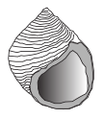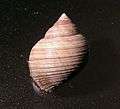Littorina saxatilis
Littorina saxatilis, common name the rough periwinkle, is a species of small sea snail, a marine gastropod mollusc in the family Littorinidae, the winkles or periwinkles. First identified in the 1700s, it has been misidentified as a new species 112 times.[2]
| Rough periwinkle | |
|---|---|
| A shell of Littorina saxatilis | |
| Scientific classification | |
| Kingdom: | |
| Phylum: | |
| Class: | |
| (unranked): | |
| Superfamily: | |
| Family: | |
| Genus: | |
| Species: | Littorina saxatilis |
| Binomial name | |
| Littorina saxatilis | |
Distribution
This species is native to the shores of the North Atlantic Ocean, including Hudson Bay, Baffin Island, Greenland, and the Barents Sea, south along the American East Coast to Chesapeake Bay, and along the European coast to the Straits of Gibraltar.
This species has also been introduced to San Francisco Bay, on the West Coast of the United States, where it was first observed in 1992.
Shell description
The shell in life often appears green with algae, but the shell itself can be white, red, or brown, sometimes with checkered lines. The shell has 4–5 whorls. Maximum recorded shell length is 19 mm.[3][4]
 Apertural view
Apertural view Abapertural view
Abapertural view A series of shells of Littorina saxatilis
A series of shells of Littorina saxatilis
Ecology
Habitat
This species frequently lives in salt marshes. it can also be found in crevices of intertidal bedrock, in empty barnacle shells, and under rocks. Like many other periwinkles, this species can survive long exposures out of the water.
The species has been recorded alive from depth range 0 – 46 m[3] or up to 183 m (for shells only).[4]
In the exposed Galician coast in the Northern Spain, two well differentiated ecotypes are adapted to different shore levels and habitats.[5] The RB ecotype (Ridged and Banded) lives on barnacles in the upper shore.[5] This ecotype displays a larger and more robust shell to resist the attack from predators such as crabs, and a smaller shell aperture in order to reduce the desiccation due to high sunshine exposure.[5] The SU ecotype (Smooth and Unbanded) is found at the lower shore living on mussels.[5] This ecotype shows a smaller and thinner shell with a wider shell aperture to allocate a relatively larger muscular foot providing a higher ability to avoid the dislodgment caused by the heavy wave action.[5] Both ecotypes coexist in an intermediate habitat at the middle shore.[5]
Genetics
Littorina saxatilis has been shown to be an excellent model system for speciation genetics.[6] In the seminal 2001 paper, Wilding et al demonstrated, using amplified fragment length polymorphism, that the low shore M form of the species were divergent from the high shore H form at number of loci despite gene flow between the forms.[6]
Feeding habits
This snail is a herbivore which grazes on the surface of rocks and mud flats.
Life cycle
The marine snail Littorina saxatilis has separate sexes, internal fertilization, and a brood pouch with non-planktonic shelled embryos.[5]
Synonyms
- Litorina groenlandica Menke, 1830
- Litorina incarnata Philippi, 1846
- Litorina marmorata L. Pfeiffer, 1839
- Litorina sulcata Menke, 1830
- Littorina castanea Deshayes in Deshayes & Milne Edwards, 1843
- Littorina danieli Locard, 1886
- Littorina groenlandica (Menke, 1830)
- Littorina neglecta Bean, 1844
- Littorina nervillei Dautzenberg, 1893
- Littorina nervillei var. major Pallary in Seurat, 1924
- Littorina nigrolineata Gray, 1839
- Littorina palliata var. turritella Schlesch, 1916
- Littorina rudis (Maton, 1797) (synonym)
- Littorina rudis f. elatior Middendorff, 1849
- Littorina rudis var. albida Dautzenberg, 1887
- Littorina rudis var. alticola Dacie, 1917
- Littorina rudis var. aurantia Dautzenberg, 1887
- Littorina rudis var. brevis Dautzenberg, 1887
- Littorina rudis var. conoidea Schlesch, 1916
- Littorina rudis var. fasciata Dautzenberg, 1887
- Littorina rudis var. finmarchia Herzenstein, 1885
- Littorina rudis var. globosa Jeffreys, 1865
- Littorina rudis var. globosa Martel, 1901
- Littorina rudis var. laevis Jeffreys, 1865
- Littorina rudis var. major Dautzenberg & P. Fisher, 1912
- Littorina rudis var. rubescens Monterosato, 1878
- Littorina rudis var. scotia S.M. Smith, 1979
- Littorina rudis var. similis Jeffreys, 1865
- Littorina rudis var. sulcata Martel, 1901
- Littorina rudis var. tenebrosapallida L.E. Adams, 1896
- Littorina rudis var. tessellata Dautzenberg, 1893
- Littorina saxatile La Roque, 1953
- Littorina saxatile saxatile La Roque, 1953
- Littorina saxatilis Johnston, 1842
- Littorina saxatilis f. abbreviata Dautzenberg & P. Fisher, 1912
- Littorina saxatilis f. conoidea Dautzenberg & P. Fisher, 1912
- Littorina saxatilis f. elongata Dautzenberg & P. Fisher, 1912
- Littorina saxatilis f. minor Dautzenberg & P. Fisher, 1912
- Littorina saxatilis groenlandica (Menke, 1830)
- Littorina saxatilis groenlandica var. sculpta Schlesch, 1931
- Littorina saxatilis jugosa Montagu, 1803
- Littorina saxatilis jugosa var. bynei Dautzenberg & P. Fisher, 1912
- Littorina saxatilis jugosa var. tenuis James, 1968
- Littorina saxatilis nigrolineata Gray, 1839
- Littorina saxatilis rudis (Maton, 1797)
- Littorina saxatilis rudis var. rudissimoides James, 1968
- Littorina saxatilis scotia Graham, 1988
- Littorina saxatilis tenebrosa (Montagu, 1803)
- Littorina saxatilis tenebrosa var. biinterrupta Fischer-Piette & Gaillard, 1963
- Littorina saxatilis tenebrosa var. bizonaria James, 1963
- Littorina saxatilis tenebrosa var. elata Dautzenberg & P. Fisher, 1912
- Littorina saxatilis tenebrosa var. maculata Fischer-Piette & Gaillard, 1963
- Littorina saxatilis var. clarilineata Fischer-Piette & Gaillard, 1971
- Littorina saxatilis var. flammulata Dautzenberg & P. Fisher, 1912
- Littorina saxatilis var. fulva Dautzenberg & P. Fisher, 1912
- Littorina saxatilis var. fusca Dautzenberg & P. Fisher, 1912
- Littorina saxatilis var. gascae Fischer-Piette & Gaillard, 1971
- Littorina saxatilis var. groenlandica (Menke, 1830)
- Littorina saxatilis var. hieroglyphica Fischer-Piette, Gaillard & Jouin, 1961
- Littorina saxatilis var. interrupta Fischer-Piette, Gaillard & Jouin, 1961
- Littorina saxatilis var. lagunae Barnes, 1993
- Littorina saxatilis var. lineata Dautzenberg & P. Fisher, 1912
- Littorina saxatilis var. lugubris Dautzenberg & P. Fisher, 1912
- Littorina saxatilis var. nigra Fischer-Piette & Gaillard, 1971
- Littorina saxatilis var. nojensis Fischer-Piette & Gaillard, 1964
- Littorina saxatilis var. rubra Fischer-Piette & Gaillard, 1971
- Littorina saxatilis var. rubrolineata Fischer-Piette, Gaillard & Delmas, 1967
- Littorina saxatilis var. salvati Fischer-Piette, Gaillard & Delmas, 1967
- Littorina saxatilis var. sanguinea Coen, 1933
- Littorina saxatilis var. sellensis Fischer-Piette & Gaillard, 1964
- Littorina saxatilis var. tractibus Fischer-Piette, Gaillard & Jouin, 1961
- Littorina saxatilis var. trifasciata Dautzenberg & P. Fisher, 1912
- Littorina saxatilis zonata Daniel, 1883
- Littorina saxoides Nardo, 1847
- Littorina simplex Reeve, 1857
- Littorina tenebrosa (Montagu, 1803)
- Littorina tenebrosa f. elatior Middendorff, 1849
- Littorina tenebrosa var. costulata Middendorff, 1849
- Littorina tenebrosa var. densecostulata Middendorff, 1849
- Littorina tenebrosa var. grisolacteus Middendorff, 1849
- Littorina tenebrosa var. intermedia Forbes & Hanley, 1850
- Littorina tenebrosa var. rubidus Middendorff, 1849
- Littorina tenebrosa var. tessellatus Middendorff, 1849
- Littorina tenebrosa var. zonatus Middendorff, 1849
- Littorina zonaria Bean, 1844
- Nerita rustica Nardo, 1847
- Turbo obligatus Say, 1822
- Turbo rudis Maton, 1797
- Turbo rudissimus Johnston, 1842
See also
- Common Periwinkle
References
This article incorporates CC-BY-2.0 text from the reference [5][6]
- Olivi G. (1792). Zoologia Adriatica, ossia catalogo ragionato degli animali del golfo e della lagune di Venezia. Bassano, Venecia [ix] + 334 + xxxii pp., 9 pls.
- Feltman, Rachel (March 12, 2015). "Nearly 200,000 'new' marine species turn out to be duplicates". The Washington Post.
- Littorina saxatilis (Olivi) Malacolog 4.1.1. A Database of Western Atlantic Marine Mollusca.
- Welch J. J. (2010). "The "Island Rule" and Deep-Sea Gastropods: Re-Examining the Evidence". PLoS ONE 5(1): e8776. doi:10.1371/journal.pone.0008776.
- Martínez-Fernández M., Bernatchez L., Rolán-Alvarez E. & Quesada H. (2010). "Insights into the role of differential gene expression on the ecological adaptation of the snail Littorina saxatilis". BMC Evolutionary Biology 10: 356. doi:10.1186/1471-2148-10-356.
- Wilding C. S., Butlin R. K. & Grahame J. (2001). "Differential gene expression between parapatric morphs of Littorina saxatilis detected using RFLP markers". Journal of Evolutionary Biology 14: 4. doi:10.1046/j.1420-9101.2001.00304.
Further reading
- Carvajal-Rodríguez, A.; Conde-Padín, P. & Rolán-Alvarez, E. (2005). "Decomposing shell form into size and shape by geometric morphometric methods in two sympatric ecotypes of Littorina saxatilis. Journal of Molluscan Studies 71: 313–318.
- Galindo, J.; Morán, P. & Rolán-Alvarez, E. (2009). "Comparing geographical genetic differentiation between candidate and noncandidate loci for adaptation strengthens support for parallel ecological divergence in the marine snail Littorina saxatilis". Molecular Ecology 18: 919–930.
- Hayward, P. J.; Ryland, J. S. (Ed.) (1990). The marine fauna of the British Isles and North-West Europe: 1. Introduction and protozoans to arthropods. Clarendon Press: Oxford, UK. ISBN 0-19-857356-1. 627 pp.
- Johannesson, B. (1986). "Shell morphology of Littorina saxatilis Olivi the relative importance of physical factors and predation". Journal of Experimental Marine Biology and Ecology 102: 183–195.
- Johannesson, K.; Johannesson, B. & Rolán-Alvarez, E. (1993). "Morphological differentiation and genetic cohesiveness over a micro-environmental gradient in the marine snail Littorina saxatilis". Evolution 47: 1770–1787.
- Reid, D. G. (1989a) "The comparative morphology, phylogeny and evolution of the gastropod family Littorinidae". Philosophical Transactions of the Royal Society of London, Series B 324: 1–110
- Reid, D. G. (1996). Systematics and evolution of Littorina. The Ray Society 463p.
- Rolán-Alvarez, E. (2007). "Sympatric speciation as a by-product of ecological adaptation in the Galicia Littorina saxatilis hybrid zone". Journal of Molluscan Studies 73: 1–10.
- Rolán-Alvarez, E.; Johannesson, K. & Erlandsson, J. (1997). "The maintenance of a cline in the marine snail Littorina saxatilis: the role of home site advantage and hybrid fitness in ecotype formation". Evolution 51: 1838–1847.
External links
| Wikimedia Commons has media related to Littorina saxatilis. |